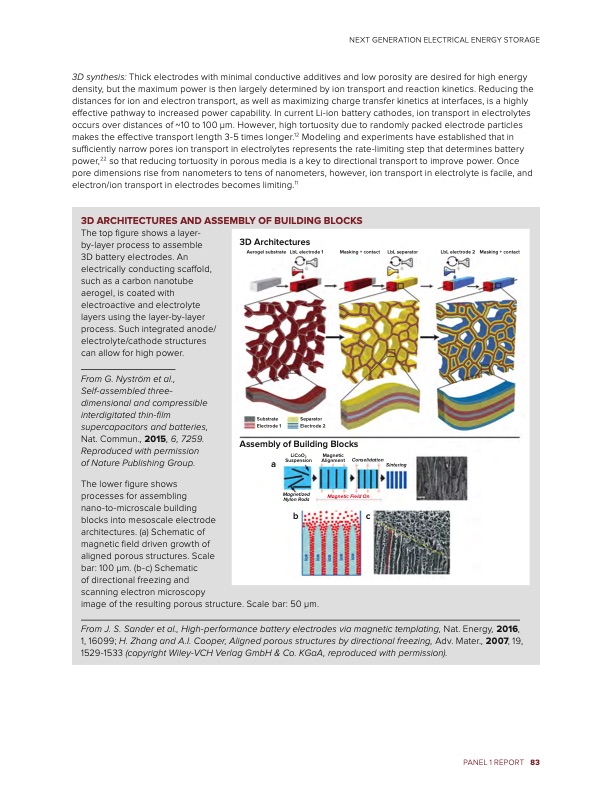
PDF Publication Title:
Text from PDF Page: 089
3D synthesis: Thick electrodes with minimal conductive additives and low porosity are desired for high energy density, but the maximum power is then largely determined by ion transport and reaction kinetics. Reducing the distances for ion and electron transport, as well as maximizing charge transfer kinetics at interfaces, is a highly effective pathway to increased power capability. In current Li-ion battery cathodes, ion transport in electrolytes occurs over distances of ~10 to 100 μm. However, high tortuosity due to randomly packed electrode particles makes the effective transport length 3-5 times longer.12 Modeling and experiments have established that in sufficiently narrow pores ion transport in electrolytes represents the rate-limiting step that determines battery power,22 so that reducing tortuosity in porous media is a key to directional transport to improve power. Once pore dimensions rise from nanometers to tens of nanometers, however, ion transport in electrolyte is facile, and electron/ion transport in electrodes becomes limiting.11 NEXT GENERATION ELECTRICAL ENERGY STORAGE 3D ARCHITECTURES AND ASSEMBLY OF BUILDING BLOCKS The top figure shows a layer- by-layer process to assemble 3D battery electrodes. An electrically conducting scaffold, such as a carbon nanotube aerogel, is coated with electroactive and electrolyte layers using the layer-by-layer process. Such integrated anode/ electrolyte/cathode structures can allow for high power. From G. Nyström et al., Self-assembled three- dimensional and compressible interdigitated thin-film supercapacitors and batteries, Nat. Commun., 2015, 6, 7259. Reproduced with permission of Nature Publishing Group. The lower figure shows processes for assembling nano-to-microscale building blocks into mesoscale electrode architectures. (a) Schematic of magnetic field driven growth of aligned porous structures. Scale bar: 100 μm. (b-c) Schematic of directional freezing and scanning electron microscopy image of the resulting porous structure. Scale bar: 50 μm. From J. S. Sander et al., High-performance battery electrodes via magnetic templating, Nat. Energy, 2016, 1, 16099; H. Zhang and A.I. Cooper, Aligned porous structures by directional freezing, Adv. Mater., 2007, 19, 1529-1533 (copyright Wiley-VCH Verlag GmbH & Co. KGaA, reproduced with permission). 3D Architectures Aerogel substrate LbL electrode 1 Masking + contact LbL separator LbL electrode 2 Masking + contact Substrate Electrode 1 Separator Electrode 2 Assembly of Building Blocks LiCoO2 Magnetic a Suspension Alignment Consolidation Sintering Magnetized Nylon Rods Magnetic Field On bc PANEL 1 REPORT 83PDF Image | Next Generation Electrical Energy Storage

PDF Search Title:
Next Generation Electrical Energy StorageOriginal File Name Searched:
BRN-NGEES_rpt-low-res.pdfDIY PDF Search: Google It | Yahoo | Bing
Sulfur Deposition on Carbon Nanofibers using Supercritical CO2 Sulfur Deposition on Carbon Nanofibers using Supercritical CO2. Gamma sulfur also known as mother of pearl sulfur and nacreous sulfur... More Info
CO2 Organic Rankine Cycle Experimenter Platform The supercritical CO2 phase change system is both a heat pump and organic rankine cycle which can be used for those purposes and as a supercritical extractor for advanced subcritical and supercritical extraction technology. Uses include producing nanoparticles, precious metal CO2 extraction, lithium battery recycling, and other applications... More Info
| CONTACT TEL: 608-238-6001 Email: greg@infinityturbine.com | RSS | AMP |